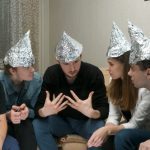 Creepy
Creepy  Creepy
Creepy  Technology
Technology 10 Scientific Breakthroughs of 2025 That’ll Change Everything
 Our World
Our World 10 Ways Icelandic Culture Makes Other Countries Look Boring
 Misconceptions
Misconceptions 10 Common Misconceptions About the Victorian Era
 Mysteries
Mysteries 10 Strange Unexplained Mysteries of 2025
 Miscellaneous
Miscellaneous 10 of History’s Most Bell-Ringing Finishing Moves
 History
History 10 Great Escapes That Ended Right Back in Captivity
 Weird Stuff
Weird Stuff 10 Fascinating Things You Might Not Know About Spiders
 Food
Food 10 Everyday Foods You Didn’t Know Were Invented by the U.S. Military
 History
History 10 Odd Things Colonial Americans Kept at Home
 Creepy
Creepy 10 More Representations of Death from Myth, Legend, and Folktale
 Technology
Technology 10 Scientific Breakthroughs of 2025 That’ll Change Everything
 Our World
Our World 10 Ways Icelandic Culture Makes Other Countries Look Boring
Who's Behind Listverse?

Jamie Frater
Head Editor
Jamie founded Listverse due to an insatiable desire to share fascinating, obscure, and bizarre facts. He has been a guest speaker on numerous national radio and television stations and is a five time published author.
More About Us Misconceptions
Misconceptions 10 Common Misconceptions About the Victorian Era
 Mysteries
Mysteries 10 Strange Unexplained Mysteries of 2025
 Miscellaneous
Miscellaneous 10 of History’s Most Bell-Ringing Finishing Moves
 History
History 10 Great Escapes That Ended Right Back in Captivity
 Weird Stuff
Weird Stuff 10 Fascinating Things You Might Not Know About Spiders
 Food
Food 10 Everyday Foods You Didn’t Know Were Invented by the U.S. Military
 History
History 10 Odd Things Colonial Americans Kept at Home
10 Reasons Dickens Would Love “The Muppet Christmas Carol” Adaptation
Since it was published in 1843, there have been dozens of adaptions of Charles Dickens’s A Christmas Carol. Many of these try to stay true to the original story, but others take a bit more creative liberty.
One of the most popular and entertaining versions of the story came out in 1993 and features a particularly well-known frog puppet. The Muppets’ version of A Christmas Carol is often hailed as one of the most accurate for multiple reasons.
This list gifts you with the 10 reasons The Muppet Christmas Carol is the most faithful adaption of the classic novel. And it illustrates why Charles Dickens would be pleased with what Kermit and the gang did with his material.
Related: Top 10 Christmas Movie Moments
10 It’s Ratty
From Oliver Twist to David Copperfield, is there any better way to show Dickensian disorder and filth than through the presence of rats?
Rats were a huge part of Dickens’s life. After being sent to work in a factory at the age of eleven, many of the future author’s diary entries featured descriptions of the “old house” being “literally overrun with rats… swarming down the cellars, the sound of their squeaking and scuffing coming up the stairs.”
The Muppet Christmas Carol does not leave out these details. In addition to all of Scrooge’s workers being played by rats, beloved New York native Muppet Rizzo the Rat follows our Charles Dickens narrator around, making jokes and giving us iconic lines like “Light the lamp, not the rat!” [1]
9 It’s Set in the Right Time and Place
A Christmas Carol is an enduring tale, and the themes of caring for your fellow man and helping others will never go out of style. The story works no matter when or where you set it, which is why, for the past 150 years, we’ve seen many adaptations. From 1998’s Scrooged, featuring Bill Murray as a humbug TV executive, to the 2019 mini-series, which was scrutinized for being too bleak and depressing.
The Muppet Christmas Carol takes place during the exact period Dickens intended it to—1843. And though the story theoretically could take place anywhere, there’s certainly something to be said for the fact that Dickens was making a statement about London at a particular point in time, so keeping it in the original setting adds another layer of meaning.[2]
8 It Leans into Sadness
When Scrooge visits his old sweetheart Belle, thanks to the ghost of Christmas Past, he relives the terrible moment when she leaves him after realizing he cares more about money than her. Belle then sings a heartbreaking ballad, “When Love Was Gone.”
The song was cut for DVD and Blu-ray releases, as Disney deemed it too sad and depressing—ironic for the company that created Up and The Fox and the Hound. Many argued that the point of A Christmas Carol was to be melancholy and that the song helped emphasize where Scrooge started to go downhill. The protestors’ voices were heard, and the song is featured in all modern versions of the movie.
Great news for parents who want their children to know the unbearable pain of debilitating love.[3]
7 Its Costumes Are Period Accurate
A Christmas Carol takes place over a period of over 60 years. Starting in 1843 (at the time of writing, present day) when Scrooge goes to sleep, all the way back to 1790, in Scrooge’s childhood, and finally in the futuristic year 1853, when Scrooge is faced with his own grave.
Given that this covers three different eras of English history (and is a children’s movie), hardly anyone would have blamed the Muppet creatives for phoning it in a bit when it comes to accurate costuming.
However, as anyone with extensive knowledge of Georgian, Regency, and Victorian-era fashion will know, they did not let this aspect of the film slack. Plaid was very popular in the 1840s, and at some point, nearly every character in the movie can be seen in it. When Scrooge visits his old boss, Fozziwig, it’s roughly 1789, a time when French fashion was all the rage. Appropriately, all the characters at Fozziwig’s party are wearing loud patterns, huge hats, and other French flairs. Everyone, that is, except for Scrooge, who wears nice clothes but of a simpler variety, indicating his poorer upbringing and lack of modernity.
In group numbers, there’s an eclectic mix of characters wearing some classic Dickensian rags and others wearing what look like nice, fancy dresses. At least, they’d look that way to the untrained eye. Those with knowledge of this era may catch that the coats and dresses on some characters are a few years out of date, indicating poverty.[4]
6 It’s Scary
Though the core story and themes are certainly appropriate for children, A Christmas Carol is similar to Dickens’s earlier novel Oliver Twist in that it deals with issues that affect children but might not necessarily entertain them.
Every adaptation of A Christmas Carol has attempted to capture the eeriness of the Ghost of Christmas Past, the bittersweetness of the Ghost of Christmas Present, and the horrifying fear of Christmas Yet to Come, but none have succeeded as well as The Muppet Christmas Carol. The Ghost of Christmas Past is a ghost-like little girl, disembodied and floating in space, and to further emphasize its otherworldliness, she is played by neither a Muppet nor a human. The Ghost of Christmas Present is a new Muppet, introduced only to age in moments to present how quickly Scrooge’s present and chance to change his ways is fading. Finally, the Ghost of Christmas Yet to Come appears as a Grim Reaper-type of faceless demon, definitely not a fun-loving puppet.
Brian Henson recalls there was a backlash against the dark nature of the film, which he defended to keep the original spirit of the book. “There were kids crying in the cinemas,” he said, but “You need to go to those dark places for the ending to be as joyous as it can be.”[5]
5 The Muppet Personalities Elevate the Backstory
One of the most ingenious ways The Muppet Christmas Carol creates a faithful retelling of Dickens’s novel isn’t through the writing or acting but merely through the characters themselves.
In the book, every character is either good or bad—it’s black and white. Bob Cratchit, Fred Scrooge, and Fezziwig are good and jolly, while Scrooge and Marley are bad. Generally, in movies and books, there needs to be some sort of backstory to establish characters as such. For example, we learn in A Christmas Carol that Marley, like Scrooge, hoarded money and thought of himself above the poor and destitute.
We don’t need to learn this in The Muppet Christmas Carol because Marley is played by two annoying and mean Muppets, Waldorf and Statler. We’re already so used to seeing these Muppets in the balcony of the theater making wisecracks and heckling Fozzie and Kermit that adults and children alike can instantly tell they’re the bad guys. Similarly, we don’t need a reason to root for Bob Cratchit since he’s played by the embodiment of decency and fairness—Kermit the Frog.[6]
4 The Characters Aren’t Realistic
Sure, you might not think of Charles Dickens as particularly over-the-top—unless you’re talking about his descriptions of how terrible Victorian London was. But each character in A Christmas Carol isn’t meant to be a particularly well rounded character. They generally represent ideals or act as foils to each other.
Think about it. What does Tiny Tim do? Not much. He’s there to serve as a symbol for the vulnerable and poor. Jacob Marley represents the consequences of greed. Fred represents the importance of family, and so on. Rather than try to flesh out each of these (compared to Scrooge) minor characters, the Muppets do what they do best: make cameos.
Robin is adorable as Tiny Tim, but being a puppet (and a frog) is not particularly believable. What kind of child is that sweet and innocent? None that I’ve ever met. But that’s because Tiny Tim isn’t meant to be an actual child you might meet, but, like all the characters, a manifestation of the book’s themes.[7]
3 Charles Dickens Narrates
Narration is often difficult to fit naturally into a movie. Voiceovers are an option, but they can seem obtrusive and invasive if not done correctly, and human characters breaking the fourth wall to tell the story can be jarring.
When figuring out how he wanted to make the film, Brian Henson thought about how “nobody had ever captured Dickens’s prose—the wonderful way he describes the scenes. So we had to put Charles Dickens in the movie.” In this case, Gonzo the Great plays Dickens, interceding at various points to explain the plot to children and insert more adult jokes for parents. His narration allows for the story to be just as dark and complicated as the original story while still keeping it appropriate and entertaining for children.[8]
2 Michael Caine Played It Straight
While Steve Martin, Elliot Gould, and Jason Segel all shine in their respective roles in Muppet films, Michael Caine does something entirely different as Ebenezer Scrooge in The Muppet Christmas Carol: He takes it seriously.
As one of the most renowned actors in the world, it may be surprising to see Caine in a children’s movie. But his performance truly elevates it to something else. Despite his puppet co-stars, Caine gives an Oscar-worthy performance of anger, grief, and fear throughout Scrooge’s journey.
And this is no accident. Rather than using the movie as a time to slack off and have some fun, Caine stated after his hiring that he meant to “play this movie like I’m working with the Royal Shakespeare Company… I will never do anything Muppety. I am going to play Scrooge as if it is an utterly dramatic role, and there are no puppets around me.”
So, even though Kermit (as Bob Cratchit) and Fozzie (as Old Fezziwig) may not be able to emote as well as humans could, main character Scrooge’s performance more than makes up for it, making this one of the most emotional adaptations of A Christmas Carol.[9]
1 It Includes Lines Directly from the Book
Just as the 1995 mini-series Pride and Prejudice was praised for its ability to lift lines directly from Jane Austen’s novel and seamlessly intertwine them into the series, The Muppet Christmas Carol is constantly quoting Charles Dickens.
Even though the Muppets are, of course, catering to children, they don’t let that stop them from directly repeating lines from Dickens’s dark book. From iconic lines like the opening “Marley was dead: To begin with” (though it’s altered to reference to “the Marleys,” since the single character is replaced by a pair to feature Waldorf and Statler) to more obscure lines, much of narrator Gonzo’s lines are taken directly from the original book.
Apart from helping the movie stay faithful to the original tale, the lines make for some pretty funny moments. One fan favorite is at the end of the film when Gonzo quotes that Scrooge became like a second father to Tiny Tim, “who did not die.” While the original line serves only as a way to inform the reader of Tiny Tim’s fate, Gonzo’s comical look to the camera and emphasis on “not” makes it seem like Tim might just live forever.[10]








